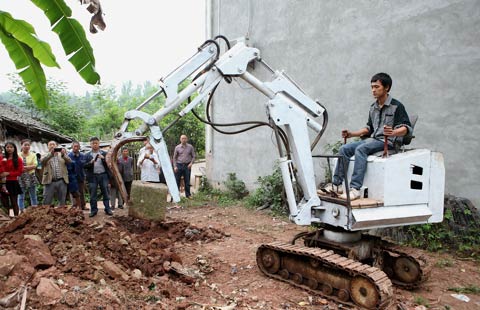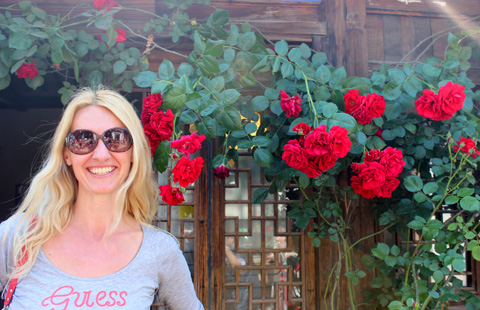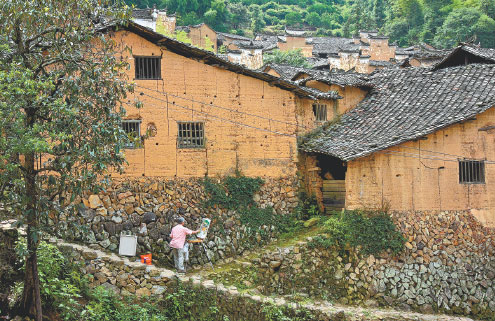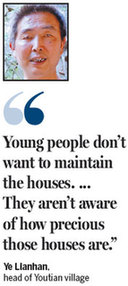Preserving the past to finance the future
Updated: 2015-05-07 07:43
By Yan Yiqi(China Daily)
|
||||||||
|
An artist paints the distinctive houses of Youtian village in Songyang county, Zhejiang province. Provided to China Daily |
Officials in rural areas are pondering ways of boosting visitor numbers to prevent some of China's oldest settlements from dying out. However, the plans may produce as many problems as they solve, and change the character of the villages irrevocably. Yan Yiqi reports from Songyang, Zhejiang province.
In the mountainous Southwestern region of Zhejiang province lies Songyang, a county containing more than 100 traditional villages whose geographical isolation has preserved their traditional charm and maintained a style of farming that has been used for centuries.
While most Chinese cities are dominated by tall concrete buildings, the villages in Songyang, with their distinctive yellow mud walls, black and gray roofs and abundant trees, retain an air of unhurried tranquility.
There's a twist, of course. Although the villages attract large numbers of visitors, such as artists and photography students, they are in danger of dying out, just as many ancient settlements across the country have done.
Youtian village has a history of more than 350 years, and nine of the houses are more than 250 years old. However, as an increasing number of young people left to search for work in the big cities, the village population dwindled and the houses fell into disrepair.
Ye Lianhan, head of the village, has witnessed the decline of his home village. "When I was a child, it was a small but very lively village. The houses linked with each other so I could visit my friend's yard by passing the kitchen of my neighbor," the 53-year-old said. "The wisdom of our ancestors was far beyond our imagination. Take the drainage system for example; the water in my yard never gets deeper than 10 centimeters no matter how hard the rain is."
Although more than 300 people are registered as living in the village, fewer than 100 actually live there permanently, and most of them are elderly. "The most common situation is that three or four seniors will live together in a house of 600 to 700 square meters, but they aren't capable of maintaining the buildings," he said.
Ye's 81-year-old father lives alone in one of the 250-year-old houses. Several years ago, part of the house collapsed and two stone pillars were stolen, and the walls are now cracked. Even so, it's still one of the best-preserved houses in the village.
"Young people don't want to maintain the houses. They would rather set them on fire and burn them down so that they can claim grants to build new ones. They aren't aware of how precious those houses are," Ye said.
He has been considering refurbishing the houses for years, but neither he nor the village has access to the large amount of money the construction work would cost.
The same story can be heard in many of the other villages in Songyang.
Song Renjian, director of the Yangjiatang Village Administrative Committee, said it costs more to refurbish an old house than to build a new one.
"We have to maintain the original look and structure of the houses, while also solving problems such as making them burglarproof and providing sanitary facilities. Also, very few workers are capable of handling projects such as this," he said.

 Ten photos you don't wanna miss - May 7
Ten photos you don't wanna miss - May 7
 Siberian tiger cubs in NE China
Siberian tiger cubs in NE China
 The wonders of the Yaxi Expressway
The wonders of the Yaxi Expressway
 China joins rehearsal for Victory Day parade in Moscow
China joins rehearsal for Victory Day parade in Moscow
 Man impresses with home-made excavator
Man impresses with home-made excavator
 Blossoms a boon for tourism
Blossoms a boon for tourism
 Camel caravan on the Silk Road
Camel caravan on the Silk Road
 Met Museum celebrates China with annual gala
Met Museum celebrates China with annual gala
Most Viewed
Editor's Picks

|

|

|

|

|

|
Today's Top News
China pledges continued help as Nepal rebuilds
Annual China-US air passenger trips top 6m
Investors tee up in US golf paradise
Met gala draws Chinese fashion bloggers' criticism
Understanding culture called key for foreign businesses in China
US authorizes ferry service to Cuba
China Daily's website takes top spot in readership
Xi will honor soldiers during Russia trip
US Weekly

|

|









